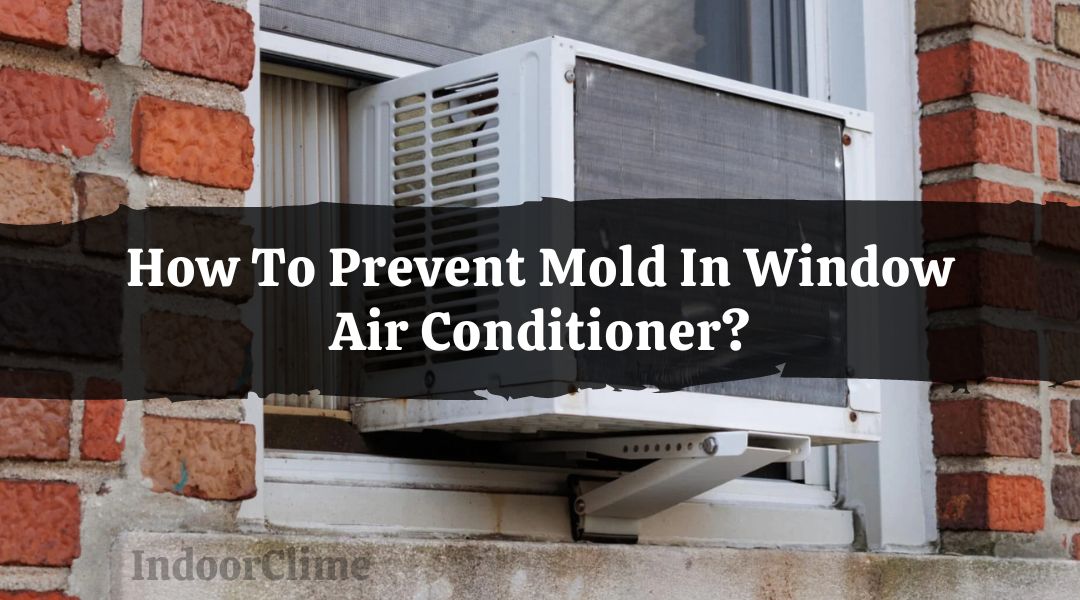If you’ve ever discovered mold in your window air conditioner, you’re probably determined to keep it from happening again. But what precisely do you do to keep mold at bay? The answer is unequivocal.
Several methods can be taken to avoid mold formation in a window air conditioner, including:
- Turning on the humidity control setting on the air conditioner
- Leaving the air conditioner on
- Keeping the unit dust-free
- Periodic deep cleaning of the air conditioner
- Spraying with white vinegar
Moldy air conditioner units are prevalent but don’t have to be. Continue reading to learn how to prevent mold in your window air conditioner and other useful mold information.
What Causes Mold in a Window Air Conditioner?
Moisture is the basic answer here. Because the air conditioner takes moisture out of the air as it operates, this makes your window air conditioner a prime target for mold.
This moisture and the unit’s dark ductwork can create an excellent mold environment. Mold also reproduces through spores, which are minuscule and dispersed through the air.
As a result, it’s essential to take preventative measures to keep mold from forming within your AC unit (the EPA recommends not running an air conditioner that may have mold in it because it might spread spores throughout your home).
The Problems Air Conditioner Mold Creates
The musty odor looks to be a primary concern in and of itself, but it is not the only issue with mold. Because your air conditioner constantly moves air throughout your home, it might pick up mold spores and transport them into your living rooms.
As a result, you may experience frequent allergy symptoms.
Worse, mold exposure can have mild to severe health implications. It can provide you with:
- Headaches
- Asthma symptoms
- Cough that persists
- Sneezing
- Discomfort in the nasal and ocular passageways
- Skin reactivity
- Infections of the lungs
As a result, it can be a significant issue. According to Environmental Health Perspectives, Dampness, and mold exposure can increase the risk of respiratory health disorders by a factor of two.
Even cleaning up a moldy air conditioner can expose you to mold.
This means you must proactively prevent mold growth rather than eradicate it.
How To Prevent Mold In Window Air Conditioner?

Preventing mold growth in your air conditioner is not an impossible undertaking. The following sections will thoroughly describe the procedures to prevent mold in your window AC.
Keep An Eye On The Humidity Level
Humidity is a natural source of moisture, which is the primary cause of mold. To discourage mold growth, the Centers for Disease Control and Prevention (“CDC”) recommends indoor humidity levels ranging from 30% to 60%.
Window air conditioners frequently share certain features with dehumidifiers; however, if relative humidity surpasses 60%, the air conditioner will likely be unsuccessful in regulating humidity.
If you notice that the air is humid even when the air conditioner is turned on, the CDC recommends using a dehumidifier to help you keep humidity under control.
Do Not Leave Your Air Conditioner On Standby
Once your window air conditioner is installed, it is critical to keep it frequently running to help avoid mold.
One standard error people make with their air conditioning unit is letting it idle (that is, letting it sit in the window without running the unit) for extended periods — think about it when you’re off to the beach during the hot summer months.
While you may believe you are being frugal by keeping your electric cost low, allowing your air conditioner to idle entirely turns off the airflow running through the air conditioner, allowing moisture to build up and produce mildew.
Instead, while you’re gone, keep your air conditioning on a low setting (or even better, take the time to clean out the unit before leaving.)
Clean The Unit Of Dust
As previously mentioned, mold spores can lodge in dust inside your air conditioner. Dust is most likely to gather in two places: on the filter or inside the device itself.
It is as simple as running a hand-held vacuum or a vacuum hose into the air conditioner to remove any remaining dust.
Remove the front cover to access the inside of the air conditioning machine.
This varies depending on the type of air conditioner, but in general, the front cover of the air conditioner will be “spring-loaded” so that you may remove it with your hands or latches that you release with your hands.
In the worst-case situation, you may have to remove a few screws.
Before attempting to reach your air conditioner’s inside, ensure it is unplugged. We also suggest taking pictures as you go so you know exactly how the equipment looked and fit together when you first got it.
Clear The Dust From The Filter
Your air conditioner’s filter resembles a fine screen enclosed in a plastic frame. It collects trash and air particles to keep them from flowing.
The filter is an essential component of the air conditioner, but the dust accumulated can supply an ideal environment for mold to thrive.
The filter is always located behind the front grill and is usually reusable. Control your hand-held vacuum or vacuum hose along the filter to eliminate dust (being careful not to damage the mesh screen).
Alternatively, you can rinse the filter under running water to remove the dust (but ensure it dries before reintroducing it into the air).
Spray Your Air Conditioner With A White Vinegar Mixture

Making a DIY white vinegar spray to prevent mold is a lesser-known preventive strategy.
While white vinegar is well-known for removing existing mold, it can also be used to prevent mold from growing in the first place.
Mix one part of white vinegar and a small amount of water in a spray bottle. Lightly spritz your AC unit (while unplugged) with the mixture, but let it dry before turning it back on.
Install A UV Filter On Your Air Conditioner
A UV filter in an HVAC system aids in controlling mold spores. It employs UV light and a high-end filter to catch and destroy allergies.
As a result, a UV filter can benefit allergy and asthma sufferers by eliminating germs and mold spores in the air.
Repair Any Water Leaks
Mold can grow as an outcome of water leaks. Therefore, water is most likely the major factor contributing to mold infestation in your home.
As a result, you must employ a reputable plumber to repair all of the leaks in your home. Mold may grow in even the most minor water leaks.
Why Mold Prevention Is Important
There are other reasons why you should keep mold out of your air conditioner, including:
Mold Has the Potential to Make You Sick
Mold, according to the Centers for Disease Control and Prevention (CDC), can cause the following health problems in humans:
- Traffic jams (stuffy nose)
- Wheezing
- Issues with the eyes (itchy, watery eyes)
- Fever and shortness of breath
It is crucial to note that not everyone who comes into contact with mold will have these health issues, but mold-sensitive ones may experience the following effects.
In addition, these health concerns can be severe, making it critical for mold protection in your air conditioner.
AC Units Effectively Spread Mold Throughout Your Home
We don’t want mold in our houses, which may be deadly on your walls or behind the toilet.
When it’s in the air conditioner, it’s blown all over your house, increasing the likelihood that you’ll frequently come into touch with it.
Even if the cleaning measures outlined above appear too time-consuming for some, your family’s health is worth the effort.
Mold Is Difficult To Remove
In most situations, once mold has made a home in your air conditioner, it is there to stay. However, seeing the black mold spots may be too late.
Moldy window AC units should be replaced regularly. This is why mold prevention is preferable to fighting existing mold in an air conditioner.
How to Clean Mold on a Window Air Conditioner?

- Put on a face mask, protective eyewear, and gloves.
- Unplug and turn off the unit.
- Remove the grille from the front of the vehicle.
- Remove the air filter from the grille on the front of the vehicle.
- Replace or dispose of the filter, or wash it in hot water with laundry detergent. Soak for 15 minutes before cleaning with a scrub brush.
- Remove the metal cover behind the front body grille and lift it straight up.
- Clean away debris from the interior of the unit with a vacuum attachment.
- Remove any noticeable mold growth with a damp cloth.
- 12 cups bleach, one tablespoon mild dish soap, and 3 gallons of boiling water in a bucket
- Soak up the solution with a cloth.
- Scrub the moldy portions of your air conditioner thoroughly, and clean the front grille if it is stale.
- Allow the solution to rest for around ten minutes before rinsing with water and a moist cloth.
- Allow the unit, air filter, grille, and metal cover to dry thoroughly.
- Reassemble the air conditioner and reconnect it to the power source.
What Is the Black Stuff In My Window Air Conditioner?
Candle Or Fireplace Soot
The black dust from your vents could be soot from candle burning or fireplace use. Also, because your air conditioner continually takes air from your home to cool it, it might pick up soot and blow it back into your home.
Duct Leaks
Your ducts are in unconditioned areas, such as an attic or ceiling. These areas are dusty and unclean, which might enter the ductwork if the ducts are faulty or disconnected.
In addition, ducts can get separated from the air handler or other ducts over time, especially if they were not built correctly in the first place.
Mold Growth
If mold is present, the air circulating through the indoor unit might transport mold spores to the ductwork, which can bloom near your vents.
In addition, mold spores can potentially infiltrate your ducting if your ducts are leaking.
Can Black Mold Grow In Window Air Conditioners?
In most cases, air conditioners and HVAC ducts are not conducive to mold growth. Mold does not find a food supply in sheet metal ducts and styrofoam channels inside window units.
However, dust frequently gathers in these areas, allowing mold to form.
Mold needs two things to thrive: wetness and an organic food source. Moisture might be caused by high humidity or an improperly cleaned-up leak or spill.
Condenser and evaporator coils are the primary sources of condensation and, as such, have the potential for water leakage if not adequately drained.
On the other hand, if there is adequate food, the mold can feed on the surface it is growing on, such as wood or carpet, or on organic particles found in dust.
Can Mold In the Window Air Conditioner Make You Sick?
Many people will be allergic to mold if they touch it. It is a widespread allergy, so expect more responses unless you are one of the lucky few who are not allergic.
Hives, rashes, and difficulty breathing due to throat swelling are mold allergy symptoms. These allergic reactions are usually modest but can be fatal in rare situations.
The most dangerous molds produce mycotoxins, a toxic chemical that causes additional medical problems. The most common mycotoxin generator is Stachybotrys Chartarum, the black mold.
Exposure to black mold has been linked to various health issues, ranging from depression to eye infections to lung hemorrhage. Therefore, it should not be taken lightly.
Mold can grow almost anywhere in your home; no matter where it grows, it can cause health problems.
On the other hand, mold in air conditioning equipment spreads spores throughout the house, making it more harmful and prone to illness.





